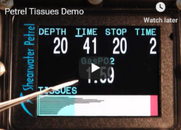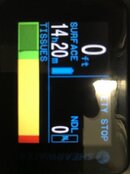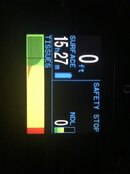My question re. using a dive computer as suggested would be if the tissues are constantly being updated when not diving. I suspect many do not, but just recalculate them at the beginning of the next dive or when queried about something like no-stop times. So if this works in real time as a meter is dependent on the computer.

My assumption was that this tissue bar graph, which you can bring up after a dive, recomputes in real time.
What I am hoping @Shearwater will tell us is whether the recalculations occur compared against newly measured barometric pressure (as when one drives up the mountain), or are calculated against the barometric pressure registered at the beginning of the dive.




 Nice. (Armed with 20/20 hindsight) I'd've coupled it with the wet sensor, so pressure sensor alone does not trigger the dive mode. I wonder if others do that.
Nice. (Armed with 20/20 hindsight) I'd've coupled it with the wet sensor, so pressure sensor alone does not trigger the dive mode. I wonder if others do that.

